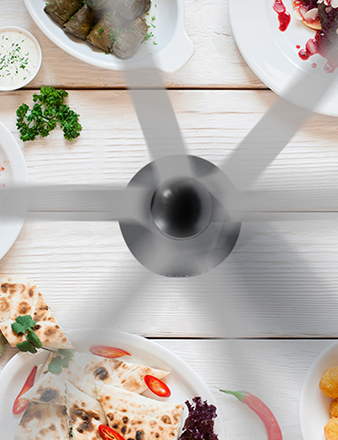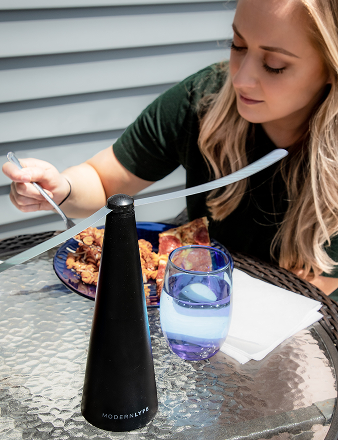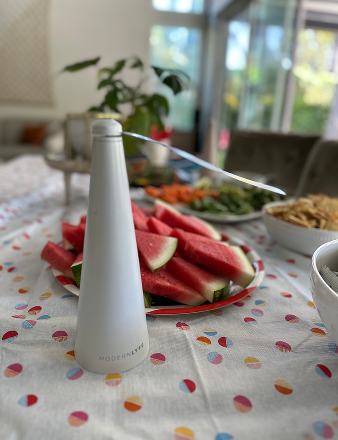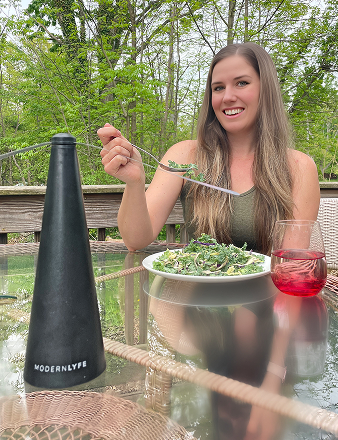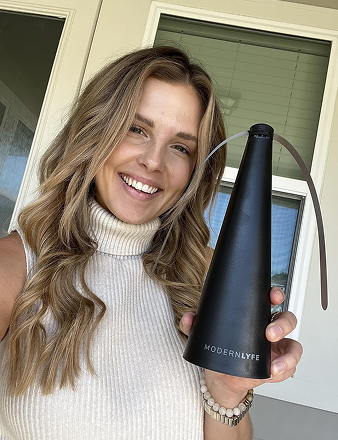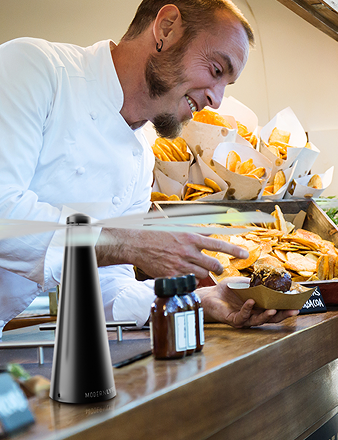Fly trap liquid is a bait—a carefully engineered attractant designed to lure flies into a trap they can't escape. Its powerful aroma, a blend of food-based ingredients, smells far more enticing to a fly than your backyard barbecue, pulling them away from your home and personal space.
This simple yet effective solution gets to the root of the problem by capturing adult flies before they can breed, breaking their lifecycle.
How Fly Trap Liquid Works
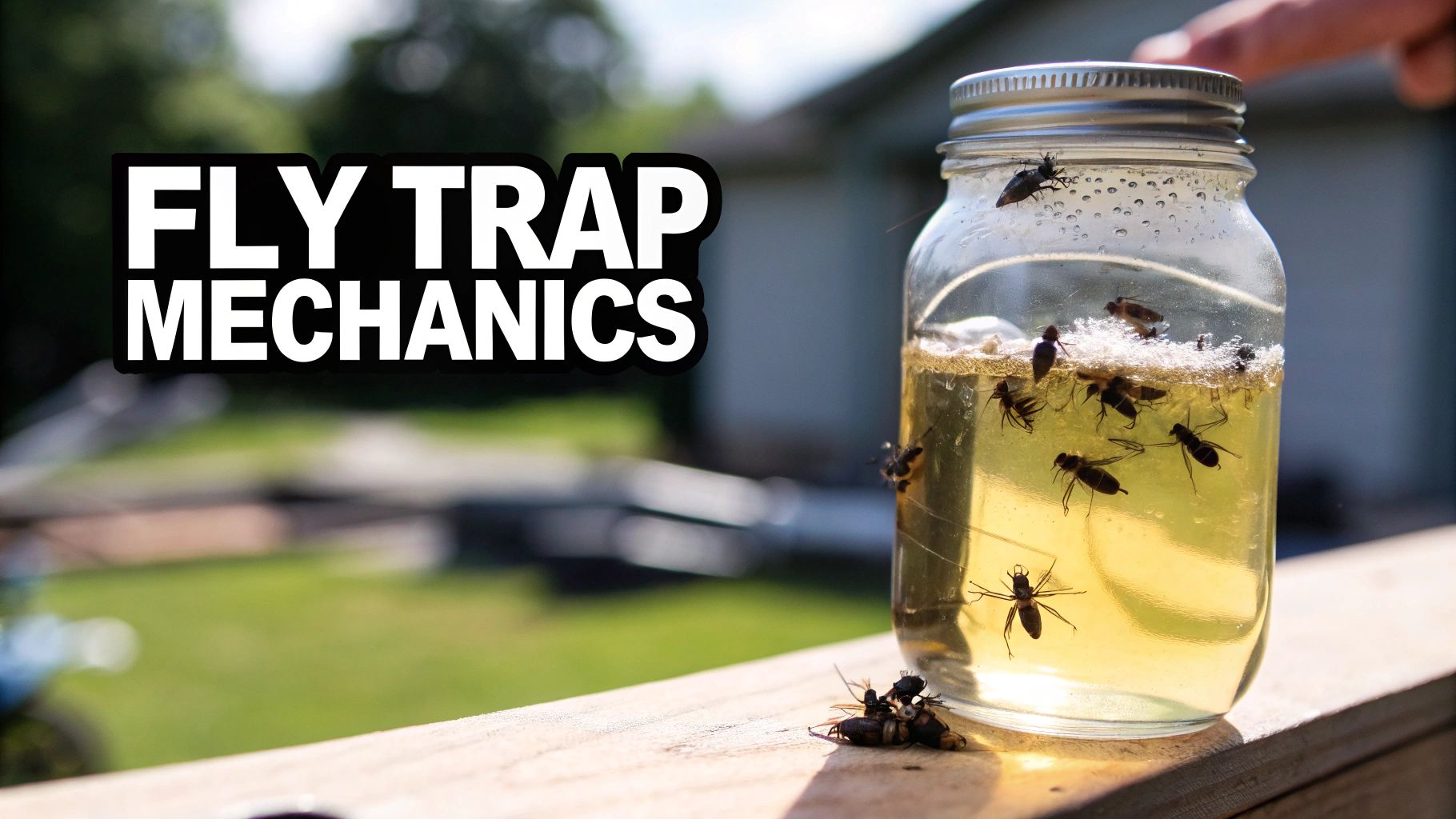
Think of fly trap liquid as an irresistible invitation that flies can't decline. This isn't just a random smelly mixture; it's a specific formula designed to tap into a fly's most basic instincts: its powerful sense of smell and its constant search for food and a place to lay eggs.
Essentially, the liquid outsmarts flies by broadcasting a scent that promises a feast. While recipes differ, most successful attractants are built around a potent, food-based lure.
The Science of Attraction
The secret weapon of any effective fly trap liquid is its smell. Flies have incredibly sharp olfactory receptors that can pinpoint food sources from impressive distances. The liquid leverages this by slowly releasing specific organic compounds into the air.
These compounds mimic the smell of decaying organic material, like overripe fruit or meat—a five-star meal for a fly. This pungent aroma acts as a powerful beacon, signaling a high-protein food source perfect for both eating and breeding.
A single housefly can detect scents from up to four miles away. This incredible sense of smell is what makes these attractants so powerful—they create a signal that is simply too strong for flies to ignore.
Some advanced formulas even add pheromones to the mix. These are chemical signals flies use to communicate, often to flag a safe feeding spot or mating ground. By including pheromones, the trap becomes even more irresistible, making it seem like a popular, fly-approved destination.
To better understand these formulas, let's break down the common components.
Key Components in Fly Trap Liquids
| Component Type | Primary Function | Common Examples |
|---|---|---|
| Food-Based Bait | Creates the core scent of a high-protein food source. | Dried egg, fish meal, food-grade esters |
| Sweeteners | Adds a sugary element to mimic rotting fruit and nectar. | Fructose, molasses, fruit juice concentrates |
| Pheromones | Amplifies the signal by mimicking fly communication chemicals. | Muscalure (Z-9-Tricosene) |
| Yeast/Activators | Kickstarts fermentation, enhancing the decaying scent over time. | Brewer's yeast, food-grade bacteria cultures |
| Surfactants | Reduces the liquid's surface tension to prevent escape. | Soap-like agents |
These ingredients work together to create a multi-layered attractant that's highly effective at drawing flies in and keeping them there.
The Two-Step Takedown
Fly trap liquids use a simple but deadly two-phase process: attraction and elimination. It’s a one-two punch that ensures any fly investigating the scent never leaves.
- Step 1: The Lure: The primary job is to pull flies away from your living areas. The scent creates an irresistible force, drawing them directly to the trap's entrance.
- Step 2: The Trap: Once a fly enters, it's game over. The liquid is often formulated with a specific surface tension that makes it impossible for the fly to gain traction and fly away. It ultimately drowns in the solution.
This dual-action method is what makes these traps so efficient. They don't just repel flies; they actively remove them from the local population. For a deeper dive, check out our guide on choosing the best food fly trap to match your needs. It's a simple, science-backed approach that provides steady defense against these annoying pests.
Choosing the Right Liquid for Your Fly Problem
Let's be clear: not all fly problems are the same. A few fruit flies in your kitchen is a different challenge than a full-blown house fly invasion on your patio. That's why picking the right fly trap liquid isn't about finding a single "best" solution—it's about matching the bait to your specific situation.
The first major decision is whether to use a pre-made commercial formula or a DIY recipe. Both have their advantages, and the best choice depends on your needs, budget, and the type of fly you're targeting.
Commercial Formulas vs. DIY Recipes
When you buy a commercial fly trap liquid, you're paying for convenience and proven results. These formulas are the product of extensive research and development focused on creating a scent that flies find irresistible. Simply open the bottle and pour—no guesswork needed.
On the other hand, a DIY approach is cost-effective and allows for customization. Using simple household ingredients like sugar, vinegar, and dish soap, you can mix an effective attractant. While these homemade solutions are great for smaller-scale problems, they often lack the power needed for a serious outdoor infestation.
Here’s a quick comparison to help you decide:
| Feature | Commercial Liquid | DIY Recipe |
|---|---|---|
| Effectiveness | High-potency, often targets multiple species. | Best for fruit flies or minor issues; can be hit-or-miss. |
| Convenience | Ready to use straight from the bottle. | Requires gathering and mixing ingredients. |
| Cost | Higher upfront cost. | Extremely cheap, uses common household items. |
| Target Species | Broad-spectrum formulas are widely available. | Tends to target specific types, like fruit flies. |
| Safety | Always check for certified non-toxic options. | Generally safe, as you’re using food-grade items. |
Ultimately, it’s a trade-off between price and performance. It's interesting to see how this plays out in the market, where affordability is a major factor. In fact, market analysis shows that fly traps priced under $30 dominate the field, making up nearly 70% of all sales. This indicates that most people, for both home and small business use, seek accessible, budget-friendly pest control. You can explore these market trends and consumer preferences to see how pricing shapes market offerings.
Keeping Kids and Pets Safe
If you have kids or pets, safety is the top priority. Fortunately, you don't have to sacrifice effectiveness. Many of the most powerful commercial fly trap liquids are 100% non-toxic. They work by using food-grade ingredients that flies love, completely avoiding harsh pesticides and chemicals.
Always check the label for phrases like "non-toxic," "pesticide-free," or "safe for use around pets and children." By choosing a non-toxic product, you can place the trap where the flies are without worrying about curious paws or little hands.
Pro Tip: Even with a non-toxic formula, it's wise to place traps just out of reach. Consider hanging them from a high tree branch or placing them on a ledge where toddlers and pets can't easily access them.
It's a simple step that lets the trap work effectively while providing peace of mind.
Your Decision-Making Checklist
Feeling stuck? No problem. Use this quick checklist to zero in on the perfect fly trap liquid for your situation.
-
Where is the problem?
- Indoors: A DIY fruit fly trap or a discreet, non-toxic commercial bait is best. You don't want anything too pungent inside.
- Outdoors: You'll need a powerful, weather-resistant commercial formula to cut through other smells and handle a larger fly population.
-
What kind of fly are you seeing?
- Fruit Flies: These are attracted to sweet and fermenting scents, like apple cider vinegar. A DIY solution works perfectly.
- House Flies, Blow Flies, etc.: Larger flies are drawn to stronger, protein-based scents. A commercial liquid formulated for general fly control will yield better results.
-
Do you have pets or children?
- Yes: This is an easy one—stick to certified non-toxic and pesticide-free formulas.
- No: You have more flexibility, but non-toxic options remain the most environmentally friendly choice.
By considering these points, you can confidently choose a fly trap liquid that is perfectly matched to solve your specific fly problem safely and effectively.
Strategic Placement for Maximum Effectiveness
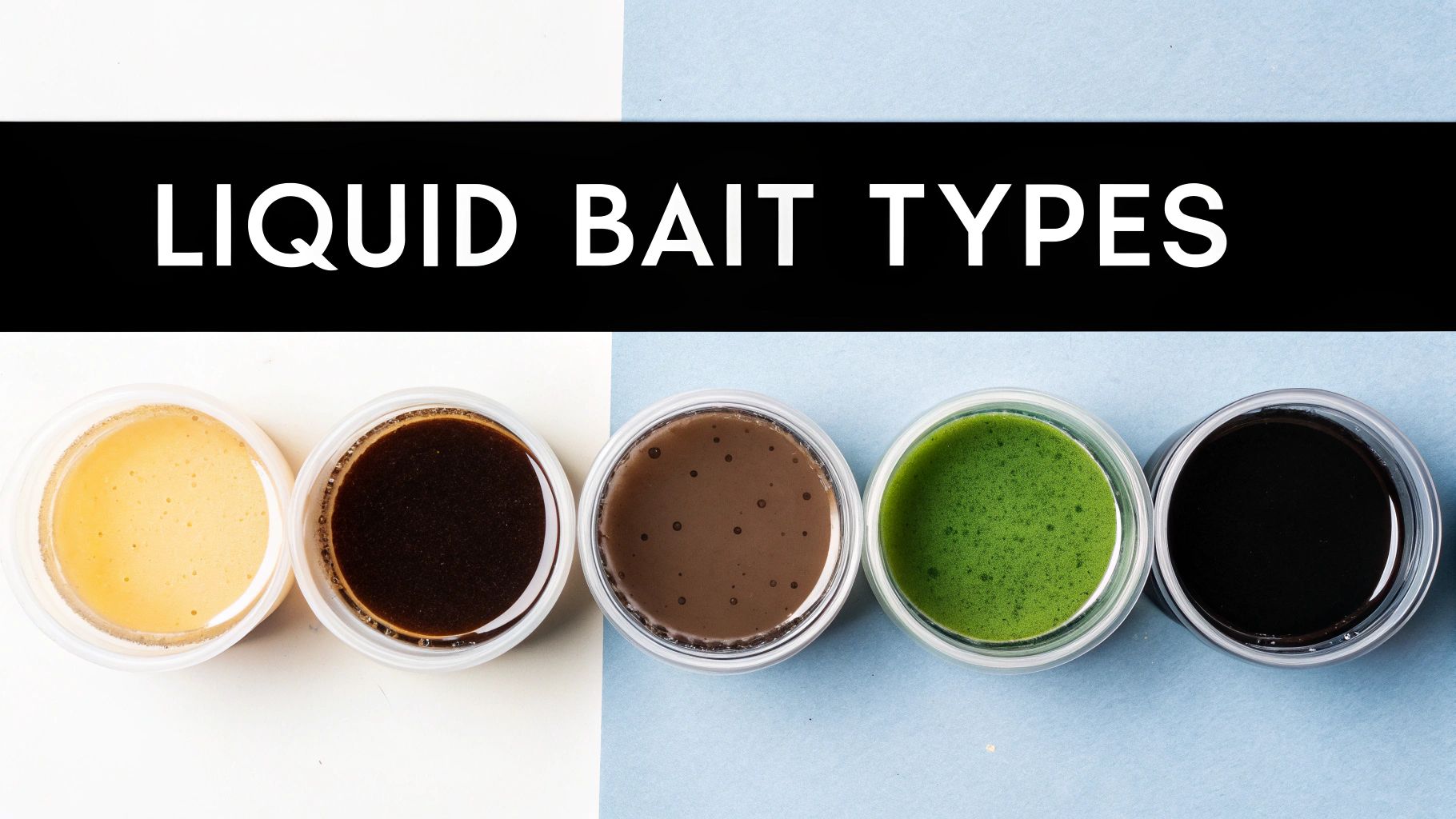
You have your fly trap liquid ready to go. That's a great start, but the job is only half done. Where you hang the trap is just as important as what’s inside it. It’s like fishing—you can have the best bait, but if you cast your line in the wrong spot, you’ll come home empty-handed.
Effective placement isn't about luck; it's about strategy. You want to intercept flies before they reach your living spaces. The goal is to create a defensive perimeter around your home or patio, luring pests toward the traps and away from you.
Thinking Like a Fly
To outsmart a fly, you need to understand its behavior. Flies are simple creatures driven by two primary instincts: finding food and seeking warmth. This means they are naturally drawn to sunny spots and any strong scents that signal a meal or a place to lay eggs.
Your placement strategy should leverage these instincts. Hanging traps in warm, sunny areas where flies already congregate gives the attractant a significant boost. The sun gently heats the fly trap liquid, amplifying its scent and broadcasting an irresistible invitation over a much wider area.
A common mistake is hanging a trap right in the middle of a patio or picnic area. This only draws flies to the very space you're trying to protect. The key is to position traps on the outskirts of your high-traffic zones.
This simple shift in strategy separates a frustrating fly problem from an effective solution. You don't put the trap where you see the flies; you put it where they're coming from.
Ideal Placement Zones
Let's get specific. Certain spots around your property are prime real estate for flies. Targeting these hotspots will yield the best results and dramatically reduce the number of flies that make it to your back door.
Here are the top zones to consider:
- Near Trash and Compost Bins: To a fly, this is a buffet. Place a trap about 10-20 feet away from garbage cans or compost piles to catch them as they investigate the source of the smell.
- Sunny Areas Away from Seating: Flies love to bask in the sun. Find a sunny spot along your property line or near a garden shed to hang a trap. It creates an appealing diversion far from where you relax.
- Around Animal Enclosures: If you have dogs, chickens, or other animals, their living areas are major fly magnets. A strategically placed trap can intercept pests before they bother your pets or move toward the house.
For a more comprehensive approach to protecting your outdoor dining areas, consider pairing traps with other solutions. Learn how a simple fly repellent fan can create a fly-free bubble at your table, complementing your perimeter traps perfectly.
A Step-by-Step Setup Guide
Setting up your trap is easy, but a few small details can make a big difference in its initial effectiveness.
- Activate the Attractant: If your trap uses a powdered attractant, add the specified amount of lukewarm water. Warm water helps the powder dissolve faster and activates the scent-releasing process.
- Hang at the Right Height: The ideal height is usually around 4-5 feet off the ground, which aligns with the natural flight path of most common houseflies. A tree branch, fence post, or shepherd's hook works great.
- Choose a Sunny Location: Sunlight is crucial. It warms the liquid, making the scent more potent and widespread. Aim for a location that gets at least a few hours of direct sun daily.
- Stay Downwind: If possible, place the trap downwind from your home or patio. This ensures that the potent smell of the trap (and the flies it catches) blows away from you.
Follow these simple placement rules, and you'll ensure your fly trap liquid works at peak efficiency, resulting in a more peaceful, pest-free space.
Keeping Your Traps Working All Season Long
Fly control isn't a one-and-done task; it's a simple, ongoing routine. Think of your fly trap as a dedicated soldier—it needs support to keep fighting effectively. A simple maintenance schedule is all it takes to keep your traps powerful from the first warm days of spring through the end of fall.
This isn't about adding another complex chore to your list. It's just a few minutes every week or two to maintain the luring power of your fly trap liquid. That small effort is the difference between a temporary fix and consistent, long-term relief from pests.
Creating a Simple Maintenance Schedule
Consistency is key to keeping fly populations down. Like watering a plant, a regular check-in ensures your trap is always active. A good schedule is easy to remember and quick to follow.
Most outdoor traps need attention every 2-3 weeks. Keep in mind this can change. Hot days can make the liquid evaporate faster, and a severe fly problem can fill a trap in just a few days.
It's a good habit to check your traps weekly, even with a quick glance. This allows you to catch any issues early and keep everything working smoothly.
Pro Tip: Set a recurring reminder on your phone for "Fly Trap Friday" or another memorable day. This turns maintenance into a regular habit, guaranteeing your traps are never neglected.
Refilling and Cleaning Your Traps
When the liquid level drops or the trap is full of flies, it's time for a refresh. Handling a full trap isn't glamorous, but doing it correctly is crucial for hygiene and effectiveness.
Here’s a clean and quick method:
- Prep for Disposal: Before opening the trap, grab a sealable bag. A zip-top plastic bag is perfect.
- Empty the Trap: Carefully pour the old liquid and captured flies into the bag. Do this away from your patio to avoid lingering smells.
- Seal and Toss: Zip the bag up tight to contain everything, then toss it in with your regular household trash.
- Rinse It Out: If you're using a reusable trap, give it a good rinse with a garden hose. Avoid using soaps or chemicals, as the residue can interfere with the new attractant.
- Add Fresh Liquid: Once clean, pour in the fresh fly trap liquid and add water according to the instructions. Hang it back in its spot, and it's ready to work again.
Troubleshooting Common Trap Problems
Even the best traps can encounter issues. If you notice a trap has suddenly stopped working, don't worry. The fix is usually simple.
-
Problem: The trap isn't catching any flies.
- Solution: Nine times out of ten, it's the location. Try moving the trap to a sunnier spot. The warmth activates the liquid's scent and makes it travel farther.
-
Problem: The liquid evaporated too quickly.
- Solution: On very hot, dry days, this is expected. Just top off the trap with a little water between full cleanings to keep the attractant active.
-
Problem: The trap is attracting the wrong insects.
- Solution: This is rare, but it can happen. First, ensure your trap is designed for flies. If it is and the problem persists, try moving it away from flowering plants that might be drawing bees or wasps.
Stick with this simple maintenance routine, and your fly traps will be a reliable and powerful part of your pest control strategy all season long.
Residential Versus Commercial Fly Control
A few flies at a backyard barbecue is an annoyance. An infestation in a restaurant kitchen is a crisis. The stakes are completely different when comparing fly control at home versus in a business, which means your strategy—and the fly trap liquid you choose—must match the mission.
For most homeowners, the goal is comfort. We want a fly trap that's safe around kids and pets, doesn't smell terrible, and eliminates flies near the patio or trash cans. The objective is simple: reclaim our living spaces.
In a commercial setting, however, fly control is a non-negotiable part of business operations. It's about passing health inspections, protecting customers, and maintaining a hard-earned reputation.
The Homefront Approach: Safety and Simplicity
When dealing with flies at home, the priorities are straightforward:
- Safety First: Non-toxic, pesticide-free formulas are essential. You don't want to worry about a curious pet or child getting into something harmful.
- Targeted Control: You're typically addressing a small, localized problem. A trap near the garbage bin is often sufficient.
- Discreet Placement: No one wants a smelly, unsightly fly trap next to their outdoor dining table. Homeowners need a solution that works without being an eyesore.
It’s all about creating a pleasant, comfortable environment for family and friends. The scale is smaller, and so are the stakes.
Commercial Fly Control: High-Stakes Sanitation
For a restaurant, farm, or food processing facility, flies are a direct threat. A single fly can carry over 100 different pathogens, making effective control an operational necessity. A bad infestation can lead to failed health inspections, contaminated products, and a public relations nightmare.
In these high-stakes environments, the needs are entirely different:
- Industrial Strength: You need a powerful formula that can compete with the abundant food sources in a commercial kitchen or on a farm and handle massive fly populations.
- Large-Scale Coverage: Traps must be deployed strategically across a wide area to create an effective barrier against infestation.
- Health Code Compliance: The solution must work while meeting strict public health and sanitation regulations.
The image below highlights the difference between a simple DIY solution and what a commercial operation requires.
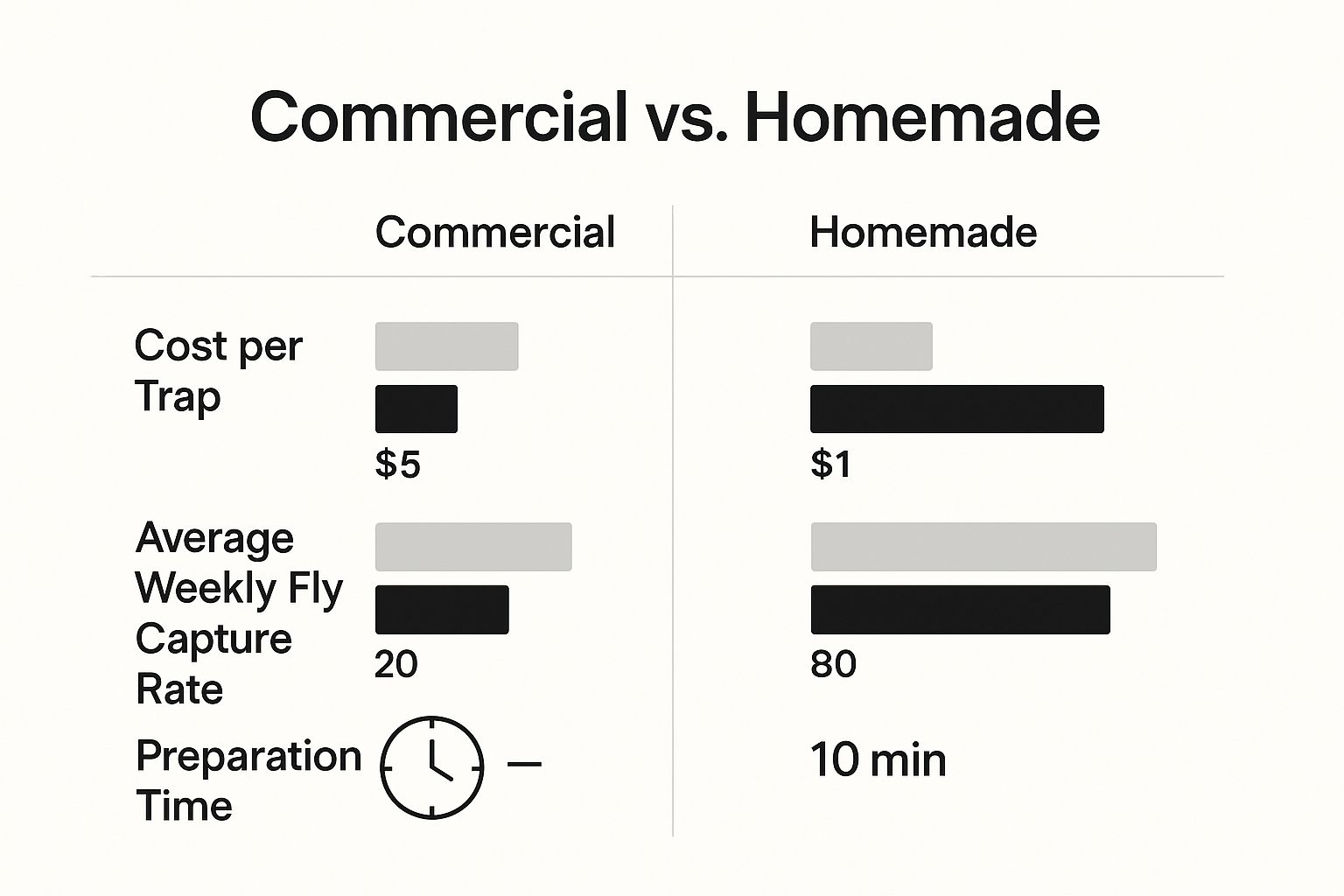
While a homemade trap is cheap and easy, its low capture rate is insufficient when a business is on the line.
The fundamental priorities for fly control shift dramatically between a home and a business. The table below breaks down these key differences.
Fly Control Priorities Home vs Business
| Consideration | Residential Priority | Commercial Priority |
|---|---|---|
| Primary Goal | Comfort and convenience | Public health and compliance |
| Safety | Non-toxic for pets/children | Food-safe and regulation-compliant |
| Odor | Low to no odor | Effectiveness overrules odor |
| Scale | Localized (e.g., patio, kitchen) | Widespread (e.g., entire facility) |
| Potency | Moderate | High-strength attractant |
| Cost | Budget-friendly and accessible | Investment in operational safety |
Ultimately, choosing the right approach means understanding that residential fly control is about personal comfort, while commercial control is about public safety and legal compliance.
This is why businesses drive the fly trap market. In 2023, the global market reached about 16.9 million units sold, with the commercial sector expected to grow to over $300 million by 2031. That’s a serious investment in sanitation, and container-style traps with liquid baits are leading the charge.
Of course, liquid traps are often just one part of a larger commercial strategy. Many businesses find a multi-layered approach works best. For instance, they might pair perimeter traps with other technologies, like learning how commercial fly fans create an air barrier to stop flies from entering a building in the first place.
At the end of the day, matching the solution to the environment is the only way to win the war against flies.
The Future of Fly and Pest Management

The simple fly trap liquid we use today is part of a much larger shift in how we handle pest control. For decades, the standard was to blanket areas with harsh chemical pesticides. Now, we are moving toward smarter, more targeted, and eco-friendly methods that work with nature, not against it.
This change is driven by a better understanding of the impact of old-school chemicals and a growing demand for safer options for our homes and businesses. The "scorched earth" strategy is out. In its place are precision and sustainability—a philosophy that enhances a simple idea like a scent-based lure with modern technology.
Innovations on the Horizon
The core principle of fly trap liquid—luring pests to a specific spot—is being taken to the next level. The pest control aisle is getting a major upgrade, with new devices that promise more efficient and hands-off solutions.
You can already see this trend in creative new tools like these:
- Solar-Powered Traps: These traps run themselves, using small solar panels to power fans that pull flies in or UV lights that attract a wider variety of insects, all without needing an outlet.
- UV Light Devices: Many flying insects are irresistibly drawn to blue or ultraviolet light. Modern traps use energy-efficient LED UV lights as a beacon, attracting pests from farther away, especially at night.
- Smart Traps: The newest traps come with sensors that can track capture counts and send a notification to your phone when it's time to empty them, removing all the guesswork.
This isn’t just a small trend; it's a massive global movement. The fly trap market is projected to hit around $415 million in 2025 and climb to $623 million by 2030. This growth is fueled by a rising awareness of health risks from pests and a major regulatory push for chemical-free alternatives. You can get a closer look at these numbers by exploring more information on the global fly trap industry growth.
Your Role in a Greener Approach
When you choose a solution like a non-toxic fly trap liquid, you are part of this positive shift. Every time you opt for a bait-based trap over a chemical spray, you're voting for a more sustainable and responsible way to manage pests.
The goal of modern pest management isn't to sterilize our environment but to restore balance. It's about managing pest populations in a way that is effective, targeted, and safe for our families, our pets, and our planet.
These simple yet powerful tools, from a basic liquid attractant to a high-tech solar-powered device, embody this new philosophy. They show that you don't need a heavy-handed chemical approach to achieve a peaceful, pest-free space. This thoughtful, targeted strategy is the future of keeping our homes and businesses comfortable and safe.
Your Top Fly Trap Liquid Questions, Answered
Even after you understand how fly trap liquid works, you'll likely have a few practical questions. Let's cover the most common ones so you can set up your traps with confidence and get the best results.
Consider this your quick-start guide to troubleshooting, from pet safety to dealing with that... unique smell.
Is This Stuff Safe for My Pets and Kids?
This is the biggest concern for most people, and the short answer is: yes, as long as you buy the right kind. The good news is that most reputable commercial fly trap liquids are specifically formulated to be 100% non-toxic and pesticide-free.
These formulas use food-grade ingredients—like yeast, sugar, and protein attractants—that flies love but are harmless to mammals. To be certain, always look for "non-toxic" or "pesticide-free" on the label. Of course, even with a safe formula, it's smart to hang traps well out of reach of curious pets and small children.
How Long Does a Batch of Liquid Last?
How long your fly trap liquid remains effective depends on two main factors: the weather and the number of flies.
- The Environment: Hot, dry weather will cause the water in your trap to evaporate faster. You may need to top it off with a little water after a week or two.
- The Fly Problem: If you're dealing with a heavy fly infestation, the trap can fill up in just a few days.
As a general rule, one batch of liquid in a reusable trap should work for about 2 to 3 weeks before needing a full clean-out and replacement. Disposable bag-style traps are typically effective until they're full.
That powerful smell is actually a good sign—it means the bait is active and working. If you notice the odor fading, that's your cue to refresh the liquid, even if the trap isn't completely full.
Why Isn't My Trap Catching Any Flies?
If your trap isn't catching anything, the problem is almost always its placement. Flies are creatures of habit; they seek warmth and sunlight, which helps the bait's scent travel farther and become more intense. A trap hidden in a cool, shady corner won't perform well.
Try moving the trap to a spot that gets several hours of direct sun each day. You'd be surprised how often this simple adjustment is all it takes to turn your trap into a fly-catching machine.
Ready to create a more comfortable, fly-free environment for your home or business? The innovative solutions from MODERN LYFE offer a stylish and effective way to protect your space. Discover the perfect fly fan for your needs and enjoy peace of mind today.

